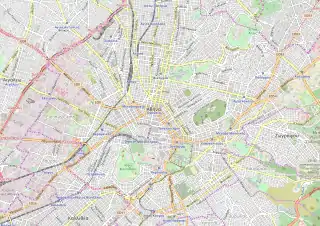Postal & Philatelic Museum of Greece
The Philatelic and Postal Museum of Greece is a museum dedicated to the philately and postal history of Greece. It is located at the junction of Stadiou Square and Fokianou Street, next to the Panathenaic Stadium (Kallimarmaro), in Athens.
Φιλοτελικό & Ταχυδρομικό Μουσείο | |
 Location within Athens | |
| Location | Athens, Greece |
|---|---|
| Type | Philatelic and postal museum |
| Website | ft-museum |
History
The establishment and operation of the Philatelic and Postal Museum was a long-standing request of the Hellenic Post Office Service and the Greek philatelic community. The project was officially supported by the Greek State in 1966. Four years later, in 1970, when the Hellenic Post Organization was established, the effort for amassing and sorting out the material meant for the museum begun. At the same time, an appropriate location to house the museum had to be found. Eventually, in 1977, benefactors Nia and Andrea Stratos donated the building that houses the museum to this day.
The Philatelic and Postal Museum opened on October 30, 1978, as part of the Hellenic Post (ELTA). Before the ELTA was privatised, the Greek government put the Museum under the control of the Ministry of Development, Competitiveness, Infrastructure, Transport and Networks. Today, the Museum lies under the jurisdiction of the Ministry of Digital Governance.[1]
Operation
The responsibilities of the Philatelic and Postal Museum are the acquisition, recording, study, research, documentation, publication, promotion, and storage of the Hellenic Philatelic and Postal exhibits. The museum displays objects used by the united Postal, Telegraph, Telephone Service (mailboxes, postman bags, horns and uniforms, envelope sealing machines, safes, bicycles and motorcycles, dispatch materials). The museum's collection also includes the first-ever Greek stamps, dating to 1861, the metal plates used for their printing, stamp sheets, stamp proofs, detailed and rough layouts, first day covers, commemorative cachets, and painting layouts of famous artists who designed stamps.
References
- "History". Philatelic and Postal Museum. Retrieved 2023-08-17.
